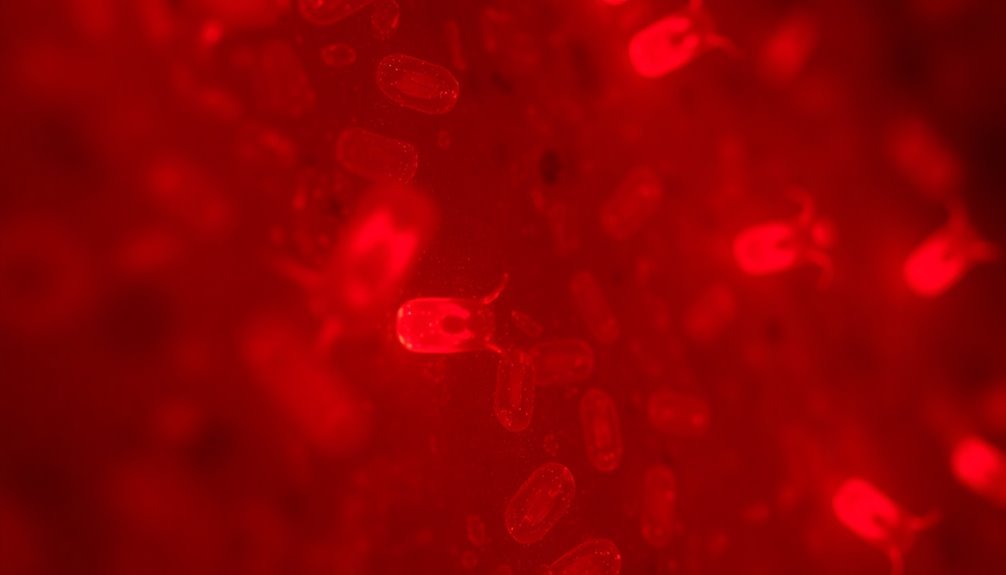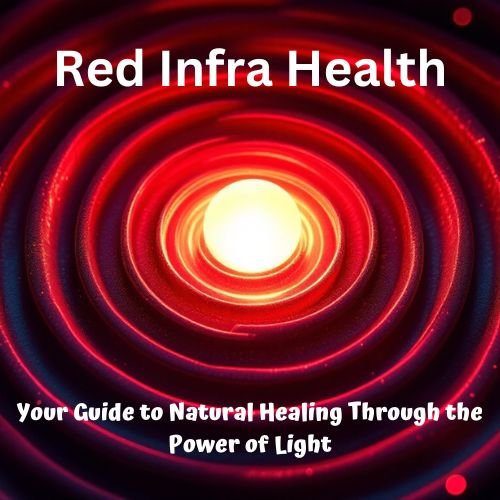Red light therapy boosts your mitochondria's performance by penetrating your cells and targeting a key enzyme called cytochrome C oxidase. When specific wavelengths (630-850 nm) hit this enzyme, they knock off nitric oxide that's blocking oxygen from binding. This allows your mitochondria to use oxygen more efficiently, ramping up ATP production – your cell's energy currency. You'll get better cellular energy production, reduced inflammation, and enhanced healing as your mitochondrial membranes become more efficient. The combination of red and near-infrared wavelengths can release even more powerful benefits for your cellular health.
The Science Behind Red Light

The fascinating interplay between red light and cellular function centers on wavelengths between 630-850 nanometers. When you expose your cells to these specific wavelengths, you're triggering a complex series of reactions within your mitochondria, the powerhouses of your cells.
The light directly impacts your cellular machinery through a process called photobiomodulation. What makes this therapy unique is its ability to penetrate your tissues without causing harmful heating effects. As the red light reaches your cells, it specifically targets cytochrome C oxidase, a significant enzyme in your mitochondria's electron transport chain. Studies show that sperm motility increases when exposed to red light stimulation.
This interaction causes nitric oxide to detach from the enzyme, allowing your mitochondria to function more efficiently. The depth of penetration varies from 0.5mm to 50mm, depending on the wavelength used, which means red light can reach deeper tissues in your body.
Your mitochondrial matrix components, including various proteins and coenzymes, respond to this light exposure by enhancing their activity. The result? Your cells produce more ATP, boost their resistance to stress, and improve their overall function.
This scientific mechanism explains why red light therapy shows promise in treating various conditions, from skin issues to muscle recovery.
Understanding Cellular Energy Production
Your cells' powerhouses, the mitochondria, use red light to boost their ATP production through enhanced electron transport in the respiratory chain.
When you expose your cells to red light wavelengths of 850nm and 940nm, you're activating cytochrome c oxidase, which increases the efficiency of cellular energy production.
This activation leads to improved electron transport capacity and higher ATP levels, giving your cells more energy to perform their essential functions. The therapeutic benefits come with no harmful effects when using specific wavelengths between 630-850 nm.
ATP Production Pathways
Understanding cellular energy production starts with ATP, nature's universal energy currency. Your cells primarily produce ATP through a complex process in the mitochondria called the electron transport chain (ETC). This remarkable system pumps protons across the inner mitochondrial membrane, creating an energy gradient that ATP synthase uses to generate ATP from ADP and phosphate.
You'll find that red light therapy can enhance this process by targeting cytochrome c oxidase, a significant component of the ETC. When red light wavelengths between 630-1000 nm reach your mitochondria, they stimulate cytochrome c oxidase by removing inhibitory nitric oxide molecules. This boost in activity helps your cells produce ATP more efficiently. The process is noninvasive and painless, making it an attractive treatment option for many conditions.
Your mitochondria's ability to generate energy depends on several factors, including oxygen availability and nutrient supply. When this process becomes impaired, it can lead to various health issues.
That's why red light therapy's potential to enhance ATP production has caught researchers' attention, particularly for conditions like neurodegenerative diseases and muscle injuries. By improving mitochondrial function through red light exposure, you're supporting your cells' natural energy production mechanisms and overall health.
Light-Enhanced Electron Transport
Red and near-infrared light dive deep into cellular function by enhancing electron transport within your mitochondria. When these specific wavelengths of light interact with your cells, they trigger a vital process involving cytochrome C oxidase (Cox), a key enzyme in cellular energy production.
The light therapy works by breaking the bond between nitric oxide and Cox. Nitric oxide normally acts as a competitive inhibitor, blocking oxygen from participating in ATP production. When photons from red and NIR light excite electrons, they help dissociate this nitric oxide, allowing oxygen to flow freely and electron transport to function more effectively.
You'll experience multiple benefits from this enhanced electron transport. Your mitochondria become more efficient and multiply in number, leading to increased ATP production through oxidative phosphorylation. This process helps your body maintain the daily ATP turnover needed for optimal function.
The therapy also reduces inflammation and improves blood flow, further supporting mitochondrial performance.
Your cells respond to this improved electron transport with better overall function. You'll see reduced oxidative stress, enhanced cellular respiration, and improved energy balance.
The combination of these effects supports your cellular health and helps maintain ideal bodily performance through increased ATP production.
Wavelengths That Power Your Cells

Different wavelengths of light interact uniquely with your cells, but the therapeutic window of 630-850 nanometers proves particularly effective for mitochondrial stimulation. Within this range, specific wavelengths target different aspects of cellular function. Your mitochondria respond especially well to light between 610-630 nm and 660-680 nm, where cytochrome C, a vital component of the electron transport chain, shows peak absorption. Research shows that 638 nm LED light can significantly enhance liver regeneration and cellular repair.
When you're exposed to 830 nm light, it enhances your cells' electron transport system and boosts cytochrome C oxidase activity. At 850 nm, the light improves your intact cell respiration and stimulates mitochondrial complexes. Even at 940 nm, you'll find enhanced mitochondrial function and improved cellular resistance to stress.
The depth of light penetration varies with wavelength. While red light works well for surface tissues, near-infrared light can reach deeper into your muscles, bones, and organs. This explains why different wavelengths are chosen for specific therapeutic purposes – shorter wavelengths for skin treatments and longer ones for deep tissue healing.
Your mitochondria respond to these wavelengths by increasing ATP production and improving overall cellular energy levels.
Boosting ATP Through Light Therapy
You'll find that specific wavelengths of red and near-infrared light directly stimulate your mitochondria's ATP production through their interaction with cytochrome c oxidase.
When the right wavelengths hit your cells, they separate nitric oxide from cytochrome c oxidase, allowing cellular respiration to continue more efficiently. The respiratory chain utilizes 40 unique proteins to facilitate this energy production process.
Choosing the ideal wavelengths (particularly 850nm and 940nm) is essential for maximizing these energy-boosting benefits, as different wavelengths trigger distinct responses in your cellular powerhouses.
Light Activates Energy Production
Light therapy releases a powerful cascade of cellular events that boost your body's energy production at the molecular level. When red light penetrates your tissues, it primarily targets cytochrome c oxidase, a key enzyme in your mitochondria's respiratory chain. This interaction kicks off several essential processes that enhance your cellular energy production.
You'll find that light therapy works by increasing your cells' ATP production through multiple mechanisms. It strengthens your electron transport system's capacity and improves mitochondrial membrane potential, leading to more efficient energy generation. The light also separates nitric oxide from cytochrome c oxidase, which allows your cellular respiration to continue unimpeded. A brief three-minute exposure daily is sufficient to achieve these therapeutic benefits.
These effects aren't just theoretical – they translate into real therapeutic benefits. You'll notice improvements in various conditions, from neurodegenerative diseases to muscle recovery. The enhanced mitochondrial function helps reduce fatigue and improve overall cellular health.
Your skin may look better as collagen production increases, and you might experience less pain due to reduced inflammation. For those with mitochondrial diseases, this therapy can improve muscle function and mobility, while also supporting better cognitive function in conditions like dementia.
Wavelength Selection Matters Most
When selecting wavelengths for red light therapy, precision matters more than intensity. The most effective wavelengths fall within the 630-850nm therapeutic window, with each range offering specific benefits for your cells' mitochondria.
Research shows that 27.7% glucose reduction occurs when using red light before meals. You'll get different results depending on your treatment goals and target depth. Red light (610-760nm) works best for skin-level therapy, while near-infrared light (760-1400nm) penetrates deeper to reach muscles, bones, and organs.
For ideal mitochondrial stimulation, you'll want to focus on 670nm, which enhances the redox state of mitochondria, or 850nm, which specifically boosts respiratory function and ATP production.
The wavelength you choose directly affects how your mitochondria respond. For instance, 940nm improves cellular viability and ATP production, while 830nm works well in pulsed applications for neuronal cell protection.
You'll need to match the wavelength to your specific health goals – what works for pain relief might differ from what's best for muscle recovery.
Remember to protect your eyes during treatment, as high-intensity LED exposure can cause damage without proper safety measures.
Mitochondrial Response to Red Light

Red light's interaction with mitochondria triggers a fascinating cascade of cellular responses that enhance energy production within these microscopic powerhouses. When your cells absorb red light, it immediately boosts the mitochondrial membrane potential and stimulates cytochrome C oxidase, an essential enzyme in the electron transport chain.
You'll find that this activation leads to increased oxygen consumption and ATP production, fundamentally supercharging your cells' energy-making capabilities. The process becomes even more efficient when the light is pulsed rather than continuous. Your mitochondria respond by improving their respiratory capacity and electron transport efficiency, which means they're creating more energy while working smarter, not harder. Studies show that ten-minute exposure periods yield the most beneficial results for mitochondrial function and ATP levels.
What's particularly interesting is how this interaction might work through mitochondrial bound water, rather than direct contact with cellular components. As your cells receive red light therapy, they'll also experience reduced levels of harmful reactive oxygen species, making them more resistant to stress.
This enhanced cellular function explains why you'll see benefits ranging from faster wound healing to improved brain function, especially when the treatment's duration is properly timed for ideal results.
Optimizing Cell Power Generation
Red light therapy optimizes your cells' power generation by stimulating cytochrome c oxidase, which boosts ATP production in the mitochondria.
You'll get the best results using light wavelengths between 630-850 nm, as this range most effectively enhances mitochondrial function and cellular energy efficiency.
Your mitochondria respond to this specific light frequency by improving their electron transport chain performance and increasing their membrane potential, leading to higher ATP output.
ATP Production Boost Mechanisms
The intricate process of cellular energy production receives a significant boost through specific wavelengths of red and near-infrared light therapy. When you expose your cells to light between 660-680 nm, you'll optimize cytochrome C oxidase activity, an essential enzyme in ATP production. This wavelength helps separate nitric oxide from the enzyme, allowing it to function more effectively.
You'll see enhanced mitochondrial membrane potential when using red and near-infrared light, particularly at 850 nm. This improvement leads to better electron transport and increased ATP production in your cells. The light therapy strengthens your cells' ability to consume oxygen and produce energy more efficiently.
Your cells will also become more resilient to external stressors. When you use wavelengths between 830-940 nm, you'll boost your cells' resistance to various forms of stress and inflammation. This enhanced cellular protection comes from improved mitochondrial function and increased ATP availability.
The combination of these effects creates a powerful mechanism for optimizing your cellular energy production, particularly in situations where your cells need extra support, such as during recovery or under metabolic stress.
Light Frequency Sweet Spots
Finding ideal light frequencies for cellular energy production centers on two key ranges: visible red light (630-760nm) and near-infrared light (760-850nm). These wavelengths have proven most effective at stimulating your mitochondria's energy-producing capabilities while remaining completely safe for regular use.
| Wavelength | Penetration | Primary Benefits |
|---|---|---|
| 630-660nm | Skin-deep | Cell proliferation, skin repair |
| 670nm | Moderate | Direct mitochondrial stimulation |
| 760-850nm | Deep tissue | Muscle and joint recovery |
| 850nm | Maximum depth | Peak electron transport activation |
| 940nm | Deep tissue | Enhanced cytochrome c oxidase activity |
You'll get the best results by targeting specific wavelengths for your needs. If you're looking to improve skin health, stick to the 630-670nm range. For deeper tissue healing or muscle recovery, you'll want to use wavelengths between 760-940nm. The 850nm wavelength particularly excels at boosting your mitochondrial electron transport system, while 670nm directly stimulates energy production within your cellular powerhouses. By matching the right wavelength to your specific needs, you'll optimize your body's energy-producing potential.
Light Exposure Duration Matters

Determining ideal exposure duration plays a critical role in red light therapy's effectiveness on mitochondrial function. Research shows that short exposure periods of 1-5 minutes can greatly boost mitochondrial activity and cellular respiration.
Continuous red-to-NIR light exposure proves more effective than pulsed light for enhancing mitochondrial function, though both methods offer distinct benefits.
When you're considering red light therapy duration, keep these key findings in mind:
- Short exposures (1-5 minutes) increase mitochondrial membrane potential and cytochrome C oxidase activity, particularly beneficial for cellular energy production.
- Continuous light exposure outperforms pulsed light for improving mitochondrial respiration and electron transport system capacity.
- Specific wavelengths (850nm and 940nm) show enhanced effectiveness during brief exposure periods.
- Duration effects vary based on the target system – neuronal cells and reproductive cells may require different exposure times for best results.
You'll get the best results by matching exposure duration to your specific needs. For instance, if you're targeting neuronal health, continuous exposure might be more beneficial, while reproductive cell function can improve with brief 1-10 minute sessions.
Cellular Healing With Red Light
Red light therapy's remarkable ability to promote cellular healing stems from its direct impact on mitochondrial function. When red light wavelengths between 630-850 nm reach your cells, they stimulate cytochrome C oxidase, a key component in your mitochondrial electron chain. This activation triggers a cascade of beneficial cellular responses that support healing throughout your body.
As your mitochondria absorb this light energy, they'll increase their production of ATP, the primary energy currency your cells need for repair and regeneration. The therapy also boosts your mitochondrial membrane potential and oxygen consumption, indicating enhanced energy production capacity. You'll benefit from improved cellular resistance to stress and more efficient tissue repair processes.
What makes this therapy particularly effective is its ability to work deep within your tissues without causing damage. As the red light penetrates your skin, it promotes healing by reducing inflammation and supporting your immune system's function.
Your cells become more resilient and better equipped to handle external stressors. This non-invasive approach to cellular healing doesn't just address surface-level issues – it works at the fundamental level of cellular energy production, making it an effective tool for thorough tissue repair and regeneration.
Energy Production Enhancement Methods

Maximizing cellular energy production through red light therapy involves several key methods that target mitochondrial function. When you expose your cells to specific red light wavelengths between 630-850 nm, you're activating multiple energy-enhancing mechanisms within your mitochondria.
Your mitochondria's electron transport chain becomes more efficient when exposed to red light, particularly at wavelengths of 660-680 nm. This increased efficiency leads to higher ATP production, which is your cells' primary energy source. The light also displaces inhibitory nitric oxide from cytochrome C oxidase, allowing for better oxygen utilization and enhanced energy production.
- Target your therapy sessions during peak cellular repair times, typically in the morning or evening.
- Position the light source at the ideal distance recommended by your device manufacturer.
- Use consistent exposure times, usually between 10-20 minutes per session.
- Combine both red and near-infrared wavelengths for maximum benefit.
Your mitochondrial membrane potential strengthens with regular exposure, leading to improved oxygen consumption and electron transport capacity. This enhanced cellular energy production supports various therapeutic benefits, from faster muscle recovery to improved skin health.
Red Light Treatment Protocols
Building on these energy production principles, effective red light treatment protocols require careful attention to wavelength selection and timing. You'll need to match specific wavelengths to your treatment goals, with 610-760nm targeting skin conditions and 760-1400nm reaching deeper tissues like muscles and joints.
| Wavelength | Target Tissue | Primary Benefits |
|---|---|---|
| 670nm | Skin/Surface | Mitochondrial repair |
| 850nm | Muscle/Joint | Enhanced ATP production |
| 940nm | Deep Tissue | Increased cell metabolism |
For best results, you'll want to take into account both continuous and pulsed light applications. Continuous exposure works well for skin-level treatments, while pulsed protocols can enhance deeper tissue penetration and cellular response. Your treatment duration should typically be brief, as short exposures have shown significant improvements in mitochondrial function, particularly in mtDNA patients.
Remember to protect your eyes with appropriate goggles during treatment, and start with shorter sessions to assess your response. While red light therapy is generally safe, you'll get the most benefit from controlled treatments under professional supervision, especially when using higher-intensity devices or treating specific health conditions.
Frequently Asked Questions
Can Red Light Therapy Interfere With Medications That Affect Mitochondrial Function?
Yes, you should be cautious as red light therapy can interact with medications affecting mitochondrial function. It's important to consult your healthcare provider, especially if you're taking antibiotics, antivirals, or chemotherapy drugs.
Does Eating Certain Foods Enhance or Reduce Red Light Therapy Effectiveness?
Yes, your diet can impact red light therapy's effectiveness. You'll boost results by eating antioxidant-rich foods and omega-3s, while processed foods and high sugar intake may reduce benefits of the treatment.
Are There Genetic Factors That Influence Individual Responses to Red Light?
Yes, your genetic makeup can affect how well you respond to red light therapy. Your mitochondrial DNA, cellular sensitivity, and specific genetic variations influence how effectively your body utilizes and benefits from red light exposure.
How Does Ambient Temperature Affect Red Light Therapy Outcomes?
While there's limited research, you'll likely get ideal results at room temperature. Your body's cellular processes work best around normal physiological temperatures, but specific effects of ambient temperature on red light therapy aren't well-documented.
Can Too Much Red Light Exposure Damage Mitochondria Over Time?
Yes, you can damage your mitochondria through excessive red light exposure. Too much intensity or duration can cause overheating, oxidative stress, and cellular damage. It's essential to follow recommended treatment protocols for safety.
In Summary
You've learned how red light therapy at specific wavelengths (630-850nm) stimulates your mitochondria, boosting ATP production and cellular energy. When you expose your cells to red light, it triggers a natural healing response, enhancing mitochondrial function and improving overall cellular health. By following proper treatment protocols and duration guidelines, you'll maximize the benefits of red light therapy for peak energy production and recovery.





Leave a Reply